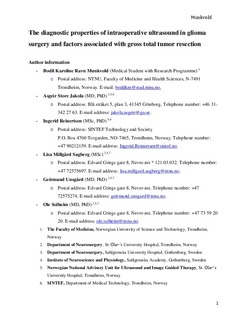| dc.contributor.author | Munkvold, Bodil Karoline Ravn | |
| dc.contributor.author | Jakola, Asgeir Store | |
| dc.contributor.author | Reinertsen, Ingerid | |
| dc.contributor.author | Sagberg, Lisa Millgård | |
| dc.contributor.author | Unsgård, Geirmund | |
| dc.contributor.author | Solheim, Ole | |
| dc.date.accessioned | 2019-04-02T08:20:46Z | |
| dc.date.available | 2019-04-02T08:20:46Z | |
| dc.date.created | 2018-04-22T12:39:18Z | |
| dc.date.issued | 2018 | |
| dc.identifier.citation | World Neurosurgery. 2018, 115 e129-e136. | nb_NO |
| dc.identifier.issn | 1878-8750 | |
| dc.identifier.uri | http://hdl.handle.net/11250/2592849 | |
| dc.description.abstract | Objective
In glioma operations, we sought to analyze sensitivity, specificity, and predictive values of intraoperative 3-dimensional ultrasound (US) for detecting residual tumor compared with early postoperative magnetic resonance imaging (MRI). Factors possibly associated with radiologic complete resection were also explored.
Methods
One hundred forty-four operations for diffuse supratentorial gliomas were included prospectively in an unselected, population-based, single-institution series. Operating surgeons answered a questionnaire immediately after surgery, stating whether residual tumor was seen with US at the end of resection and rated US image quality (e.g., good, medium, poor). Extent of surgical resection was estimated from preoperative and postoperative MRI.
Results
Overall specificity was 85% for “no tumor remnant” seen in US images at the end of resection compared with postoperative MRI findings. Sensitivity was 46%, but tumor remnants seen on MRI were usually small (median, 1.05 mL) in operations with false-negative US findings. Specificity was highest in low-grade glioma operations (94%) and lowest in patients who had undergone prior radiotherapy (50%). Smaller tumor volume and superficial location were factors significantly associated with gross total resection in a multivariable logistic regression analysis, whereas good ultrasound image quality did not reach statistical significance (P = 0.061).
Conclusions
The specificity of intraoperative US is good, but sensitivity for detecting the last milliliter is low compared with postoperative MRI. Tumor volume and tumor depth are the predictors of achieving gross total resection, although ultrasound image quality was not. | nb_NO |
| dc.language.iso | eng | nb_NO |
| dc.publisher | Elsevier | nb_NO |
| dc.rights | Attribution-NonCommercial-NoDerivatives 4.0 Internasjonal | * |
| dc.rights.uri | http://creativecommons.org/licenses/by-nc-nd/4.0/deed.no | * |
| dc.title | The diagnostic properties of intraoperative ultrasound in glioma surgery and factors associated with gross total tumor resection | nb_NO |
| dc.type | Journal article | nb_NO |
| dc.type | Peer reviewed | nb_NO |
| dc.description.version | acceptedVersion | nb_NO |
| dc.source.pagenumber | e129-e136 | nb_NO |
| dc.source.volume | 115 | nb_NO |
| dc.source.journal | World Neurosurgery | nb_NO |
| dc.identifier.doi | 10.1016/j.wneu.2018.03.208 | |
| dc.identifier.cristin | 1580851 | |
| dc.description.localcode | © 2018. This is the authors’ accepted and refereed manuscript to the article. This manuscript version is made available under the CC-BY-NC-ND 4.0 license http://creativecommons.org/licenses/by-nc-nd/4.0/ | nb_NO |
| cristin.unitcode | 194,65,0,0 | |
| cristin.unitcode | 194,65,30,0 | |
| cristin.unitname | Fakultet for medisin og helsevitenskap | |
| cristin.unitname | Institutt for nevromedisin og bevegelsesvitenskap | |
| cristin.ispublished | true | |
| cristin.fulltext | postprint | |
| cristin.qualitycode | 1 | |

